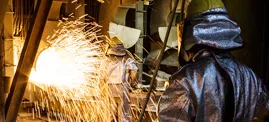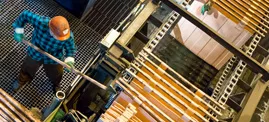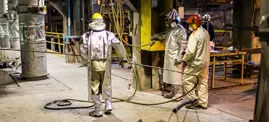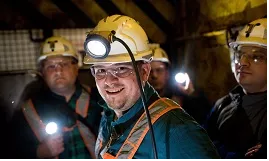General Information
The primary product of the Legnica Copper Smelter located in the Lower Silesia area of Poland is electrolytic copper in the form of cathodes weighing approx. 100 kg.
The quality of the cathodes is guaranteed by the internationally-recognised HML brand. The cathodes have been listed under this brand since 1990 on the London Metal Exchange and Shanghai Futures Exchange (SHFE) as the highest quality "A" grade. The by-products from the production are nearly 100% put to economic use with benefits for the environment.
Currently, the Legnica Copper Smelter produces more than 120 thousand tonnes of electrolytic copper every year.
The Legnica Copper Smelter has a certificate confirming that in the production of copper cathodes, round billets from smelted cathode copper, copper sulphate, nickel sulphate, refined lead and in the monitoring and measurement of environmental impact and use, it meets the requirements of the standards: PN-EN ISO 9001, PN-EN ISO 14001, PN-N 18001 and OHSAS 18001.
Since 2010, the Legnica Copper Smelter has been one of the companies which can boast the title of a Company Friendly to Employees over 45 years of age.
In 2017, the Legnica CS and other divisions of KGHM Polska Miedź S.A. implemented and certified a system compliant with the PN-EN ISO 50001 standard, thus extending the Integrated Management System to the field of energy management.
On 28 June 2019, performance tests of a new, third anode rotary-casting-refining furnace used for the production of copper anodes were commenced at the Legnica Copper Smelter. The advanced furnace is fed with high quality recycling materials with more than 90% Cu content, which can be supplied with liquid blister copper. The furnace meets the highest environmental standards and features an advanced, high-efficiency process gas treatment unit.
History
The Legnica Copper Smelter was established in 1951 under the name Legnica Metallurgical Works. On 24th December 1953, copper from ore, from the so-called Old Copper Belt, was extracted for the first time.
On 19 March 1959, the plant was transformed into the Legnica Copper Smelter, reaching the annual production capacity of 12.5 thousand tonnes of electrolytic copper.
The discovery of the new copper ore deposit and the construction of the Lubin and Polkowice mines led to the expansion of the facility and the increase of its production capacity in 1960 to 60 thousand tonnes annually.
In July 1970, the Legnica copper smelter/refinery became part of the Copper Mining and Smelting Industrial Complex (KGHM). Since then, the facility has been steadily modernised, adapted to technological progress and global production standards, especially in respect of environmental protection.
Production
Production in the Legnica Copper Smelter is based on the technology of copper concentrate smelting in shaft furnaces.
The main stages of the process are:
- Preparation of charge for smelting – suitably prepared concentrate briquettes with a content of approx. 15–20% copper, slag and coke;
- Smelting – as a result of which a copper matte is obtained, which is an alloy of sulphides, mainly of copper and iron;
- Converting, i.e. processing copper matte in a converter furnace (oxidisation of sulphides) to obtain converter blister copper with 98.5% Cu content;
- Fire refining in anode furnace to remove impurities and cast copper anodes;
- Electrorefining, during which anode copper is dissolved in the electrolyte and deposited on the cathode.
A 99.99% Cu copper cathode is the final product, which is sold or processed further in the Cedynia Rolling Mill. The sludge remaining after electrorefining is further processed to recover silver, gold and platinum group metals.
Lead Refinery Plant: input material
- crude lead with a Pb content of approximately 99%,
- crude lead with increased Ag content – with Pb content of approx. 97-98% Pb and Ag content above 0.15%.
Crude lead is cast into blocks of approx. 3 Mg. This material (or HMG product) is then fire refined in the Refinery Plant of the Legnica Copper Smelter. It is one of the methods of purification of crude lead in order to obtain refined lead for sale to external customers.
Lead Refinery products:
- soft lead cast into pig sows weighing approx. 42 kg:
- 990R with a Pb content of 99.99%,
- 985R with a Pb content of 99.985%,
- 970R with a Pb content of 99.970%,
- bismuth lead with a minimum content of 8% Bi, the Bi content is, on average, 12.5% – cast in blocks.
- KGHM led is sold to global potentates operating in the automotive and motive-power battery industry.





